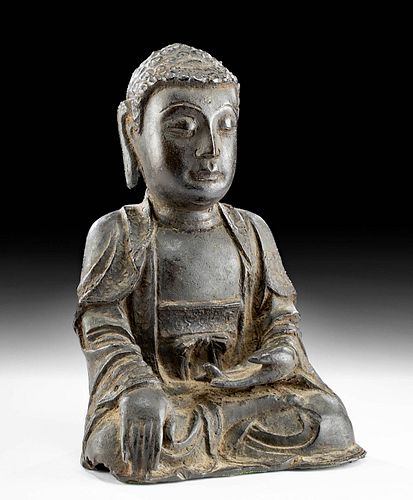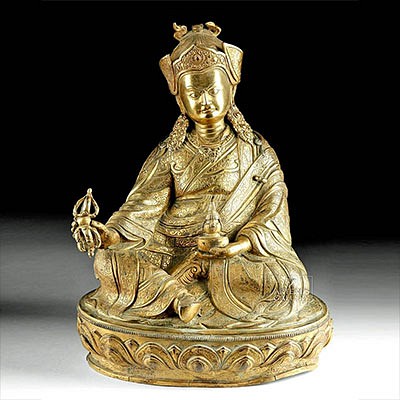14th C. Korean Joseon Bronze Shakyamuni Buddha
Lot 71
About Seller
Artemis Fine Arts
686 S Taylor Ave, Ste 106
Louisville, CO 80027
United States
Selling antiquities, ancient and ethnographic art online since 1993, Artemis Gallery specializes in Classical Antiquities (Egyptian, Greek, Roman, Near Eastern), Asian, Pre-Columbian, African / Tribal / Oceanographic art. Our extensive inventory includes pottery, stone, metal, wood, glass and textil...Read more
Estimate:
$3,600 - $5,000
Absentee vs Live bid
Two ways to bid:
- Leave a max absentee bid and the platform will bid on your behalf up to your maximum bid during the live auction.
- Bid live during the auction and your bids will be submitted real-time to the auctioneer.
Bid Increments
| Price | Bid Increment |
|---|---|
| $0 | $25 |
| $300 | $50 |
| $1,000 | $100 |
| $2,000 | $250 |
| $5,000 | $500 |
| $10,000 | $1,000 |
| $20,000 | $2,500 |
| $50,000 | $5,000 |
| $100,000 | $10,000 |
| $200,000 | $20,000 |
About Auction
By Artemis Fine Arts
Mar 11, 2021
Set Reminder
2021-03-11 12:00:00
2021-03-11 12:00:00
America/New_York
Bidsquare
Bidsquare : Art of Asia | Antiquity to Present
https://www.bidsquare.com/auctions/artemis-gallery/art-of-asia-antiquity-to-present-6497
Featuring antiquities, ancient and works of art ranging from the third millennium BCE to the present from China, Japan, South and Southeast Asia, and Korea. Including jades, bronzes, lacquer, textiles, paintings, prints, sculpture, ceramics, metalwork, and other art forms in other media. Artemis Fine Arts info@artemisfinearts.com
Featuring antiquities, ancient and works of art ranging from the third millennium BCE to the present from China, Japan, South and Southeast Asia, and Korea. Including jades, bronzes, lacquer, textiles, paintings, prints, sculpture, ceramics, metalwork, and other art forms in other media. Artemis Fine Arts info@artemisfinearts.com
- Lot Description
East Asia, Korea, Joseon period, ca. 14th to 16th century CE. A hollow cast leaded bronze Buddha (Shakyamuni, the Enlightened form), dressed in traditional robes with an elegant sash tied in a bow around the waist. Seated in full lotus position, his hands are presenting the abhaya mudra, the "gesture of fearlessness". Buddha's contemplative peaceful visage is comprised of downcast eyes, an urna over the forehead, an elegant nose, pursed lips, and characteristically elongated ears - all topped by a curled coiffure. The ushnisha takes the form of a large ovoid protuberance at the front of the head. Size: 4.375" L x 6" W x 8.375" H (11.1 cm x 15.2 cm x 21.3 cm)
Buddha's robes are skillfully rendered, draped in a naturalistic way, while his facial features are serene and lifelike. The statue presents a peaceful countenance as Buddha has acquired wisdom and knowledge after attaining enlightenment,. His elongated ears are a physical feature symbolic of the Buddha's time as a prince when he wore elaborate ear ornaments to demonstrate wealth and prosperity. Of course, the prince stopped wearing them when he left the palace to become an ascetic; however, his earlobes remained stretched signifying a conscious decision to reject the material world in exchange for spiritual enlightenment and simultaneously suggest that the Buddha can hear all that is asked for and needed in the earthly world. Those half-closed eyes indicate a meditative state - at once looking both outward and inward. Beyond the multi-layered meaning embodied in the iconography of this piece, the sculptor's artistry and technique are very impressive.
Since Buddhism was a proselytizing religion, it spread widely from its locus of origination in India. The form of Buddhism that reached those in East Asia is known as Mahayana (the Great Vehicle). What sets this sect apart is its emphasis on attaining salvation; this made for the exaltation of the bodhisattva, selfless beings who sacrificed their own buddhahood in order to help others achieve enlightenment. Buddhism came to Korea from China in 372 CE.
Provenance: private Hawaii, USA collection; ex-private Micklautz collection, Hawaii, USA, collected from 1940-1998
All items legal to buy/sell under U.S. Statute covering cultural patrimony Code 2600, CHAPTER 14, and are guaranteed to be as described or your money back.
A Certificate of Authenticity will accompany all winning bids.
We ship worldwide and handle all shipping in-house for your convenience.
#162829Petite hole below bow and a few minor casting flaws. Collection label on underside. Leaded bronze has developed a deep patina over the centuries. Green felt pieces on underside to prevent scratching surfaces when displayed.Condition
- Shipping Info
-
All shipping is handled in-house for your convenience. Your invoice from Artemis Gallery will include shipping calculation instructions. If in doubt, please inquire BEFORE bidding for estimated shipping costs for individual items.
-
- Buyer's Premium



 EUR
EUR CAD
CAD AUD
AUD GBP
GBP MXN
MXN HKD
HKD CNY
CNY MYR
MYR SEK
SEK SGD
SGD CHF
CHF THB
THB















